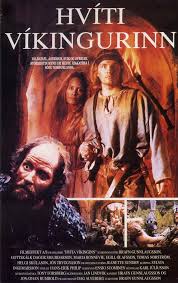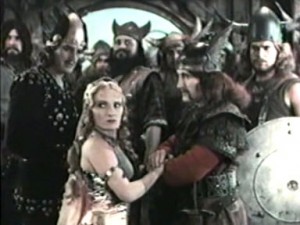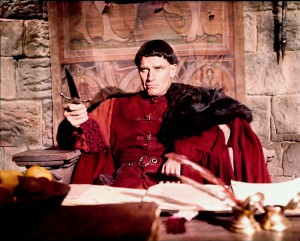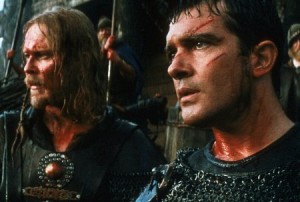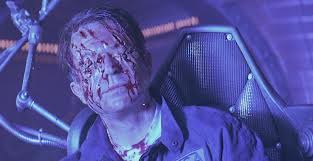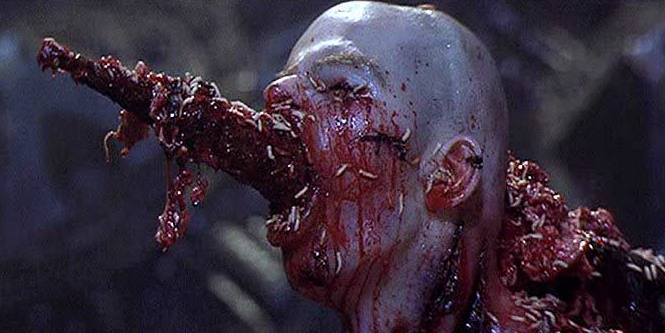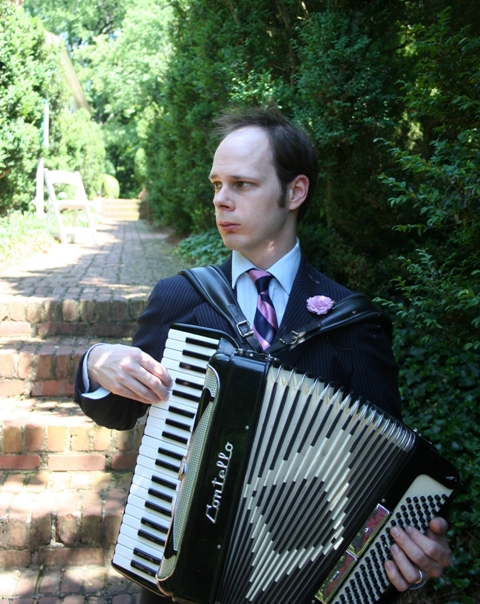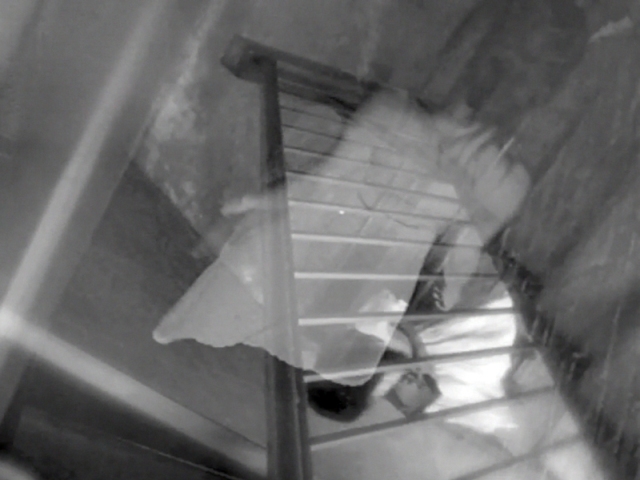 WHEN THE RAVEN FLIES (Iceland/Sweden 1984); Dir. Hrafn Gunnlaugsson; Starring Jakob Þór Einarsson; Sunday, June 23; 3 p.m.; Plaza Theatre; Preshow presentation and weapons/crafts for sale by Sons of Loki; Sponsored by Scandinavian American Foundation of Georgia; $8 general admission, $6 for SAFG members; PG-13; violence; parents should exercise caution when bringing children; Trailer; Facebook event page.
WHEN THE RAVEN FLIES (Iceland/Sweden 1984); Dir. Hrafn Gunnlaugsson; Starring Jakob Þór Einarsson; Sunday, June 23; 3 p.m.; Plaza Theatre; Preshow presentation and weapons/crafts for sale by Sons of Loki; Sponsored by Scandinavian American Foundation of Georgia; $8 general admission, $6 for SAFG members; PG-13; violence; parents should exercise caution when bringing children; Trailer; Facebook event page.
By Anya Martin
Vikings may come from cold climates, but Dark Age Scandinavians are hot right now, at least on screen. The TV series, VIKINGS, was such a hit that The History Channel has renewed it for a second season. With promises of capturing the authentic violence of the Vikings in Dark Age Britain, HAMMER OF THE GODS (2013) hits theaters July 5. The main villain in THE AVENGERS (2012) was Norse trickster god Loki, and THOR: THE DARK WORLD, a second feature about that Norse-God-turned-Marvel-Superhero premieres in November. Even Mel Gibson supposedly has BERSERKER, a “real and visceral” Viking feature in preproduction.
 In the midst of this seeming Viking fever, critically acclaimed Viking adventure movie WHEN THE RAVEN FLIES (HRAFNINN FLYGUR) will get a rare return to the big screen at the Plaza Theatre on Sun. June 23 at 3 p.m. WHEN THE RAVEN FLIES recounts an Irishman’s quest for revenge on the Viking raiders who savagely killed his parents and abducted his sister. Ancient Norse gods figure prominently in the plot, and the prerequisite violence ensues. However, the film is as much a Western in its structure as a mythological saga with striking visuals of the desert replaced by stunning cinematography of the unique Icelandic landscape. Director Hrafn Gunnlaugsson describes himself as a disciple of Sergio Leone, John Ford and Akira Kurosawa, and the influence of all three is apparent. WHEN THE RAVEN FLIES is evocative of A FISTFUL OF DOLLARS, in that a mysterious stranger Gestur (Jakob Þór Einarsson) plays off tensions between Thor and Erik, the two brothers who lead the Viking band.
In the midst of this seeming Viking fever, critically acclaimed Viking adventure movie WHEN THE RAVEN FLIES (HRAFNINN FLYGUR) will get a rare return to the big screen at the Plaza Theatre on Sun. June 23 at 3 p.m. WHEN THE RAVEN FLIES recounts an Irishman’s quest for revenge on the Viking raiders who savagely killed his parents and abducted his sister. Ancient Norse gods figure prominently in the plot, and the prerequisite violence ensues. However, the film is as much a Western in its structure as a mythological saga with striking visuals of the desert replaced by stunning cinematography of the unique Icelandic landscape. Director Hrafn Gunnlaugsson describes himself as a disciple of Sergio Leone, John Ford and Akira Kurosawa, and the influence of all three is apparent. WHEN THE RAVEN FLIES is evocative of A FISTFUL OF DOLLARS, in that a mysterious stranger Gestur (Jakob Þór Einarsson) plays off tensions between Thor and Erik, the two brothers who lead the Viking band.
WHEN THE RAVEN FLIES has won several awards, including being voted one of the outstanding films of the 1980s at the Tokyo International Film Festival and Gunnlaugsson winning the 1985 Guldbagge Award for Best Direction, the Swedish equivalent to the Oscars. It was also nominated for the 1986 International Fantasy Film Award for Best Film.The movie is the first of the Raven Trilogy, which includes IN THE SHADOW OF THE RAVEN (Í SKUGGA HRAFNSINS, 1987) and EMBLA (2007), aka the director’s cut of THE WHITE VIKING (1991), which was originally edited by that film’s producers without Gunnlaugsson’s approval.
If the melding of real Viking lore and Leone couldn’t be cool enough, the screening will be preceded by a live weapons demonstration by the Sons of Loki. These contemporary Vikings will also be present in the Plaza Lobby before and after the movie with Viking handicrafts and weaponry for sale and to answer questions about Scandinavian culture in the Dark Ages.
Still over the history of Hollywood, Viking movies have been relatively rare, compared to other historic-based genres such as the Western or the sword-and-sandle epic. And good ones with any relevance to actual Viking culture even rarer. Therefore, at ATLRetro, we decided to dig a little deeper to excavate a brief saga of Norse-inspired cinema.
The first appearance of Vikings on film that we could find was THE VIKING (1928), a silent that chronicles Leif Ericsson‘s journey to the New World. The costumes apparently are strictly Wagner, the weaponry inauthentic and the actual history tenuous, but Leif’s father enthusiastically slaughters Christians and Princess Helga has a sexy winged helmet and heavy black eyeliner.
Unfortunately, Hollywood didn’t return to the world of the Vikings until the 1950s when a sudden splash of features hit the big screen. The first, PRINCE VALIANT (1954), was based on the popular comics series, directed by Henry Hathaway (who would go on to direct TRUE GRIT[1969]) and starred a young Robert Wagner. It was a fun sword-and-sorcery romp with links to the King Arthur legend and the bonus that the sword actually sung, but the plot has virtually nothing to do with authentic Vikings. Always one to follow a trend as cheaply as possible, Roger Corman followed with THE SAGA OF THE VIKING WOMEN TO THE WATERS OF THE GREAT SEA SERPENT (1957). In this cheesy fantasy frolic, a young way-pre-FALCON CREST Abby Dalton leads a bevy of scantily clad Norse babes to battle a monster and rescue a missing man.
 Then came THE VIKINGS (1958), the first actual epic Hollywood treatment starring Kirk Douglas, Tony Curtis, Ernest Borgnine and Janet Leigh. Full of battles and striking cinematography in Norwegian locations, this romanticized story of two brother vying for a Welsh princess was directed by Richard Fleischer (20,000 LEAGUES UNDER THE SEA [1954]) and also benefitted from visual designs by Harper Goff, another 20,000 LEAGUES veteran as art director. Some time around then, by the way, was the only other Norse-inspired TV series, TALES OF THE VIKINGS, which ran about 19 episodes from 1959-60. Alas most of the footage is lost, but it lifted scenes and props directly from THE VIKINGS movie. You can hear the jaunty theme song here! Oh, wait, there was also the silly British children’s cartoon NOGGIN THE NOG which ran from 1959 to the mid-70s.
Then came THE VIKINGS (1958), the first actual epic Hollywood treatment starring Kirk Douglas, Tony Curtis, Ernest Borgnine and Janet Leigh. Full of battles and striking cinematography in Norwegian locations, this romanticized story of two brother vying for a Welsh princess was directed by Richard Fleischer (20,000 LEAGUES UNDER THE SEA [1954]) and also benefitted from visual designs by Harper Goff, another 20,000 LEAGUES veteran as art director. Some time around then, by the way, was the only other Norse-inspired TV series, TALES OF THE VIKINGS, which ran about 19 episodes from 1959-60. Alas most of the footage is lost, but it lifted scenes and props directly from THE VIKINGS movie. You can hear the jaunty theme song here! Oh, wait, there was also the silly British children’s cartoon NOGGIN THE NOG which ran from 1959 to the mid-70s.
 Italian giallo director Mario Bava (DANGER:DIABOLIK; BARON BLOOD) also tried his hand on two spaghetti Viking features, ERIK THE CONQUEROR (1961) and KNIVES OF THE AVENGER (1966) with American action hero Cameron Mitchell, who would go on to become best known as Uncle Buck in 1960s TV Western series THE HIGH CHAPARRAL. The first steals its tale of two brothers plot directly from THE VIKINGS, but is noteworthy for rich cinematography, strong action and dancing vestal virgins. California-based living history and educational group, the Vikings of Bjornstad point out in their wonderful Viking Movie List (see link at end), “This is a Viking-related movie. It’s 786 AD. The ships had red and white striped sails. Once in a while, someone yells “Odin!'” They go on to mention inaccurate costumes that even sometimes have clearly visible zippers, an “underground throne room left over from some Biblical Philistine movie” and a Viking village that seems to be made out of Lincoln logs. KNIVES OF THE AVENGER is basically a spaghetti Western reset in the Dark Ages mixed with pirates, supernatural magic and lots of knife-throwing which the trusty Vikings of Bjornstad spare no punches to declare “Worst Viking Movie Ever!” As for Cameron Mitchell, maybe he aspired to be the Clint Eastwood of Italian Viking epics since he also starred in THE LAST OF THE VIKINGS (L’ULTIMO DEI VIKINGHI, 1961) and ATTACK OF THE NORMANS (I NORMANNI, 1962).
Italian giallo director Mario Bava (DANGER:DIABOLIK; BARON BLOOD) also tried his hand on two spaghetti Viking features, ERIK THE CONQUEROR (1961) and KNIVES OF THE AVENGER (1966) with American action hero Cameron Mitchell, who would go on to become best known as Uncle Buck in 1960s TV Western series THE HIGH CHAPARRAL. The first steals its tale of two brothers plot directly from THE VIKINGS, but is noteworthy for rich cinematography, strong action and dancing vestal virgins. California-based living history and educational group, the Vikings of Bjornstad point out in their wonderful Viking Movie List (see link at end), “This is a Viking-related movie. It’s 786 AD. The ships had red and white striped sails. Once in a while, someone yells “Odin!'” They go on to mention inaccurate costumes that even sometimes have clearly visible zippers, an “underground throne room left over from some Biblical Philistine movie” and a Viking village that seems to be made out of Lincoln logs. KNIVES OF THE AVENGER is basically a spaghetti Western reset in the Dark Ages mixed with pirates, supernatural magic and lots of knife-throwing which the trusty Vikings of Bjornstad spare no punches to declare “Worst Viking Movie Ever!” As for Cameron Mitchell, maybe he aspired to be the Clint Eastwood of Italian Viking epics since he also starred in THE LAST OF THE VIKINGS (L’ULTIMO DEI VIKINGHI, 1961) and ATTACK OF THE NORMANS (I NORMANNI, 1962).
In general, the 1960s weren’t good to the Vikings on screen, whether outright fantasy or not. THE LONG SHIPS (1964) is a lightweight adventure about a Viking quest for a golden bell in the Holy Land. Directed by Jack Cardiff, cinematographer of THE VIKINGS, and starring Richard Widmark as a Viking warrior and Sidney Poitier as a Moorish king, the movie is not really very Viking except for the presence of a long ship and round shields. But the action scenes nonetheless are amplified by lush Yugoslavian locations, and the titles were designed by Maurice Binder who crafted the Bond openers. Not surprisingly, Charlton Heston also did an obligatory stint as a Norman war lord in THE WAR LORD (1965) charged with defending his Duke’s land again Frisian invaders, who are costumed to look like Vikings, not a far stretch considering they came from near Denmark and were eventually conquered. Despite the stringy chainmail and Hollywood backlot locations, The Vikings of Bjornstad give this one a thumbs up, noting that Heston is well cast and it’s “one of the few films that touches on the differences between the Christian Normans and the pagans they ruled.” They also wouldn’t mind seeing a better update of another Hollywood film that had potential, ALFRED THE GREAT (1969), which starred David Hemmings as King Alfred and Michael York as Viking Chief Guthrum.
 Britain’s Hammer Films, known for its high quality low budget horror, served up THE VIKING QUEEN (1967). The goofy plot is involves women wearing much too little to be comfortable in British climates, a Viking-Roman forbidden romance and a Brits versus Romans rebellion which evokes Celtic tribal queen Boudicca. Nobody obviously cared to check and see that Vikings didn’t raid the U.K. coast until long after the Romans had already left. Meanwhile, Danish film HAGBARD AND SIGNE (aka THE RED MANTLE/DEN RODE KAPPE, 1967) transplanted a ROMEO AND JULIET storyline to two warring Viking families. Filmed in Iceland, Roger Ebert called it “a beautiful, lean spare film…the sleeper of the year,” and the Vikings of Bjornstad overall give it a thumbs up for aesthetics and action for the time.
Britain’s Hammer Films, known for its high quality low budget horror, served up THE VIKING QUEEN (1967). The goofy plot is involves women wearing much too little to be comfortable in British climates, a Viking-Roman forbidden romance and a Brits versus Romans rebellion which evokes Celtic tribal queen Boudicca. Nobody obviously cared to check and see that Vikings didn’t raid the U.K. coast until long after the Romans had already left. Meanwhile, Danish film HAGBARD AND SIGNE (aka THE RED MANTLE/DEN RODE KAPPE, 1967) transplanted a ROMEO AND JULIET storyline to two warring Viking families. Filmed in Iceland, Roger Ebert called it “a beautiful, lean spare film…the sleeper of the year,” and the Vikings of Bjornstad overall give it a thumbs up for aesthetics and action for the time.
 Perhaps mercifully the long ships barely got unmoored during the ’70s, with the highest profile feature THE NORSEMAN (1978) sinking at the box office despite starring a hunky Lee Majors, at the peak of his SIX MILLION DOLLAR MAN fame, with a Tom Selleck moustache as Greenland’s Prince Thorvald. It followed the frequent Viking movie plot of a journey to the New Land, in this case to free his father King Eurich (Mel Ferrer) who is imprisoned by Native Americans, and the brawny cast also included quirky character actor Jack Elam, then a Western staple; NFL stars Fred Biletnikoff and Deacon Jones, and Denny Miller (TARZAN THE APE MAN, 1959). Oh, lest we forget, Walt Disney action-adventure flick THE ISLAND AT THE TOP OF THE WORLD (1974) included a lost Viking colony.
Perhaps mercifully the long ships barely got unmoored during the ’70s, with the highest profile feature THE NORSEMAN (1978) sinking at the box office despite starring a hunky Lee Majors, at the peak of his SIX MILLION DOLLAR MAN fame, with a Tom Selleck moustache as Greenland’s Prince Thorvald. It followed the frequent Viking movie plot of a journey to the New Land, in this case to free his father King Eurich (Mel Ferrer) who is imprisoned by Native Americans, and the brawny cast also included quirky character actor Jack Elam, then a Western staple; NFL stars Fred Biletnikoff and Deacon Jones, and Denny Miller (TARZAN THE APE MAN, 1959). Oh, lest we forget, Walt Disney action-adventure flick THE ISLAND AT THE TOP OF THE WORLD (1974) included a lost Viking colony.
In the ’80s, ERIK THE VIKING (1989) literally became a bad joke. Alas it was to be a Monty Python vehicle starring Graham Chapman, but while Terry Jones directed and John Cleese plays the villain, audiences just didn’t find it funny maybe because of the sheer unlikelihood of Mickey Rooney, Eartha Kitt and Imogen Stubbs appearing in even a satire of a Norse saga. Tim Robbins valiantly gave his best effort to star as Erik who ironically was tired of marauding and goes on a quest for a magic horn of peace.
 Well, that’s in the English and apparently Italian speaking world of mainstream movies. In Iceland where Vikings actually lived, the 1980s produced a number of features that purported to be more authentic takes on Norse culture. The first was OUTLAW, THE SAGA OF GISLI (UTLAGINN, 1981), based directly on the Gisla saga. Then director Hrafn Gunnlaugsson embarked on WHEN THE RAVEN FLIES, the film which is playing at the Plaza and became the first installment of a Viking trilogy. Norway also produced THE LITTLEST VIKING (1989), a charming children’s tale about a daydreaming boy who seeks to end a feud with another clan. It apparently has lots of stunning fjord shots.
Well, that’s in the English and apparently Italian speaking world of mainstream movies. In Iceland where Vikings actually lived, the 1980s produced a number of features that purported to be more authentic takes on Norse culture. The first was OUTLAW, THE SAGA OF GISLI (UTLAGINN, 1981), based directly on the Gisla saga. Then director Hrafn Gunnlaugsson embarked on WHEN THE RAVEN FLIES, the film which is playing at the Plaza and became the first installment of a Viking trilogy. Norway also produced THE LITTLEST VIKING (1989), a charming children’s tale about a daydreaming boy who seeks to end a feud with another clan. It apparently has lots of stunning fjord shots.
In the ’90s and 2000s, the mainstream Viking feature took a turn towards being more gritty and gory, allegedly to be true to the times or well, because, dark sells movie tickets. Several interesting ventures featuring high-profile directors and actors sailed onto the big screen. The first was ROYAL DECEIT (aka PRINCE OF JUTLAND, 1994), a supposedly period-accurate retelling of HAMLET starring Christian Bale as a sixth century Danish prince whose father (Tom Wilkinson) is murdered by a power-hungry uncle (Gabriel Byrne, who would be back in Viking robes as the surly old chieftain in The History Channel’s VIKINGS this spring). Of course, he has the hots for his hot mama (who else but Helen Mirren?!). The Vikings of Bjornstad like that the costumes, weaponry and sets are simple, hence probably more period accurate, but otherwise found it disappointing despite what would seem to be a strong cast. The European version is 17 minutes longer than the US/Region I DVD version.
Next up is the uber-violent THE VIKING SAGAS (1995), directed by Michael Chapman, the cinematographer of Martin Scorsese‘s RAGING BULL (1980). It starred Ralf Moeller (TV’s CONAN, GLADIATOR) and was actually filmed in Iceland. Alas, the acting and script are not much, but it has a mythic quality with a magic sword – as much a must seemingly for a Viking movie as a medieval fantasy one – and more of an authentic look than most of its predecessors, actual Icelandic movies excepted.
And then THE 13TH WARRIOR (1999) nailed the look and feel of a Norse legend perhaps better than any Hollywood film that came before it. Originally titled EATERS OF THE DEAD and based on a Michael Crichton novel, it was meant to be a gory but realistic retelling of BEOWULF, but really more captured the spirit of a Robert E. Howard short story though its outsider hero, an Arab ambassador played by Antonio Banderas, was more spirit and intellect than Conan the Barbarian brawn. Unfortunately, director John McTiernan (DIE HARD, PREDATOR) was not allowed the final cut (the idea of a director’s version someday being released seems increasingly remote especially with McTiernan now in prison). However, enough of McTiernan’s vision remained that THE 13TH WARRIOR acquired a loyal fan following (including a high recommend from ATLRetro and an even better authority – the Vikings of Bjornstad).
Yeah, we are going to skip quickly over the disappointing PRINCE VALIANT (1997) – ATLRetro would love to see a PRINCE VALIANT that’s true to Hal Foster‘s wonderful comic which has been recently resurrected by masterful illustrator Gary Gianni, but this is NOT it. And no time is worth devoting to BEOWULF (1999) starring Christopher Lambert who at some point after GREYSTOKE did completely forget how to act. And the Vikings of Bjornstad say everything worth saying about BERSERKER: HELL’S WARRIOR (2004) in this phrase – “time-traveling immortal Viking vampires who wear sunglasses in discotheques…So overdone.”
 The Vikings of Bjornstad rank Polish movie THE OLD FAIRY TALE (STARA BASN, 2003) as “the best Viking movie” for its historical accuracy. Directed by Jerzy Hoffman, who has been called Poland’s John Ford, the 9th century story revolves around a wicked Polish king and a Viking-raised hero. Apparently, Viking reenactment is big in Poland, which the Vikings of Bjornstad think may have contributed to it, first, getting made, and second, its high quality. Also well worth a view for its stunning Icelandic scenery and interesting take on the quintessential Saxon/Norse legend is BEOWULF AND GRENDEL (2005), starring a pre-300 Gerard Butler and featuring some of the best Viking era costumes of any film.
The Vikings of Bjornstad rank Polish movie THE OLD FAIRY TALE (STARA BASN, 2003) as “the best Viking movie” for its historical accuracy. Directed by Jerzy Hoffman, who has been called Poland’s John Ford, the 9th century story revolves around a wicked Polish king and a Viking-raised hero. Apparently, Viking reenactment is big in Poland, which the Vikings of Bjornstad think may have contributed to it, first, getting made, and second, its high quality. Also well worth a view for its stunning Icelandic scenery and interesting take on the quintessential Saxon/Norse legend is BEOWULF AND GRENDEL (2005), starring a pre-300 Gerard Butler and featuring some of the best Viking era costumes of any film.
In South Africa-filmed low-budget BEAUTY AND THE BEAST (BLOOD OF BEASTS, 2005), Odin punishes a Viking princess (Jane March) by trapping her in a castle with a beast. A Gallic bande dessinee hero finally gets big-screen treatment in the French animated comedy ASTERIX AND THE VIKINGS (2006) which seems to forget that Vikings weren’t around yet in AD 50. Robert Zemeckis‘s much-touted 3D BEOWULF (2007) honed so close to the original poem, probably thanks to Neil Gaiman being involved in the script, but yes, the animation even of beautiful Angelina Jolie as Grendel’s evil mother, is decidedly creepy.
 PATHFINDER (2007) starred Karl Urban, who certainly looked mighty Norse as Eomer in THE LORD OF THE RINGS trilogy, as a Viking raised by Native Americans who ends up leading the tribe that raised him in battle against new Viking invaders. A crappy remake of a much better 1987 Norwegian movie, the story really comes from Lapland/Sammi mythology. Directed by Marcus Nispel (TEXAS CHAINSAW MASSACRE [2003], CONAN [2011] ), it’s gory melodrama with lots of mist. The same year (2007) also saw the release of the more serious and well-reviewed SEVERED WAYS: THE NORSE DISCOVERY OF AMERICA.
PATHFINDER (2007) starred Karl Urban, who certainly looked mighty Norse as Eomer in THE LORD OF THE RINGS trilogy, as a Viking raised by Native Americans who ends up leading the tribe that raised him in battle against new Viking invaders. A crappy remake of a much better 1987 Norwegian movie, the story really comes from Lapland/Sammi mythology. Directed by Marcus Nispel (TEXAS CHAINSAW MASSACRE [2003], CONAN [2011] ), it’s gory melodrama with lots of mist. The same year (2007) also saw the release of the more serious and well-reviewed SEVERED WAYS: THE NORSE DISCOVERY OF AMERICA.
Jim Caviezel (THE PASSION OF THE CHRIST) travels back from the future to 8th century Norway in OUTLANDER (2008). Viewers who ignore that this mash-up of Norse mythology and sci-fi is light on history may have silly fun. It features both laser guns and swords, a monster, John Hurt as the old king, Sophia Myles as the prerequisite sexy princess and Ron Perlman as a gruff Viking with, let’s just say, poor manners.
 And then there’s VALHALLA RISING (2009). Director Nicholas Winding Refn (DRIVE) spares no punches with the ultra-violence in which Christian Vikings and a mute slave (Mads Mikkelsen, HANNIBAL, CASINO ROYALE) headed for the Holy Land get blinded by fog and end up in the New World. An article in Movie Fanfare on the “Top 13 Viking Films You Need to See” (see link at end) perhaps put it best: “VALHALLA RISING plays like THE VIKINGS co-directed by Terrence Malick and Italian gore specialist Umberto Lenzi!”
And then there’s VALHALLA RISING (2009). Director Nicholas Winding Refn (DRIVE) spares no punches with the ultra-violence in which Christian Vikings and a mute slave (Mads Mikkelsen, HANNIBAL, CASINO ROYALE) headed for the Holy Land get blinded by fog and end up in the New World. An article in Movie Fanfare on the “Top 13 Viking Films You Need to See” (see link at end) perhaps put it best: “VALHALLA RISING plays like THE VIKINGS co-directed by Terrence Malick and Italian gore specialist Umberto Lenzi!”
And oh yeah, there was some movie about a Marvel super-hero named THOR (2011).
For more about Vikings in the Movies, check out the Vikings of Bjornstad’s Viking Movie List, as well as Movie Fanfare’s “Top 13 Viking Films You Need to See.”

